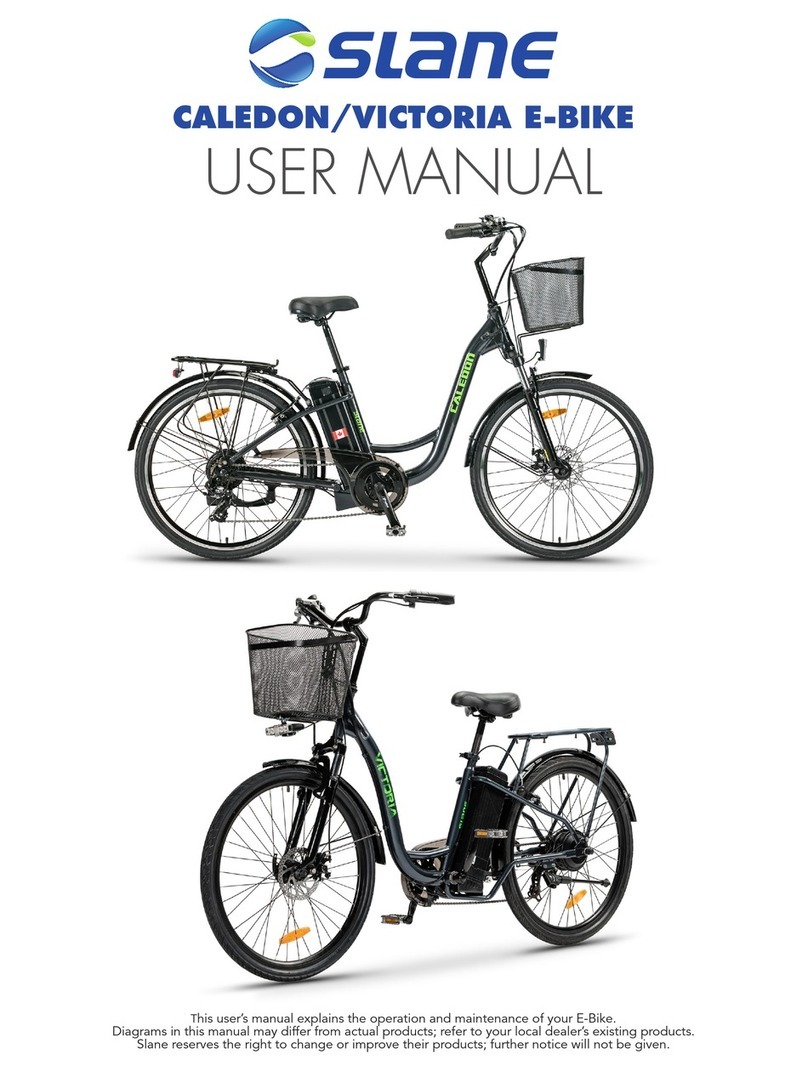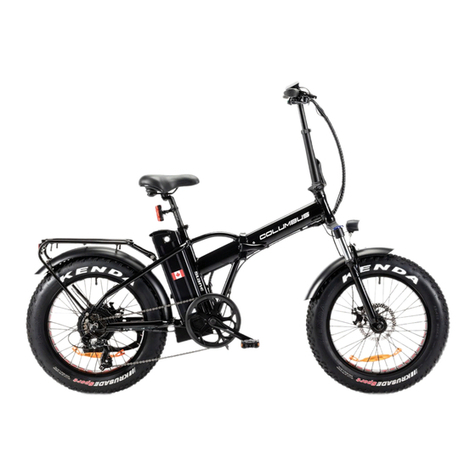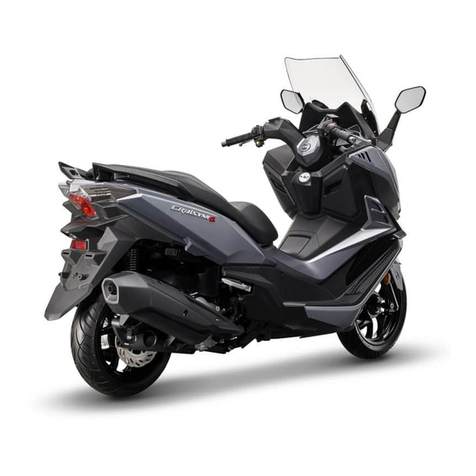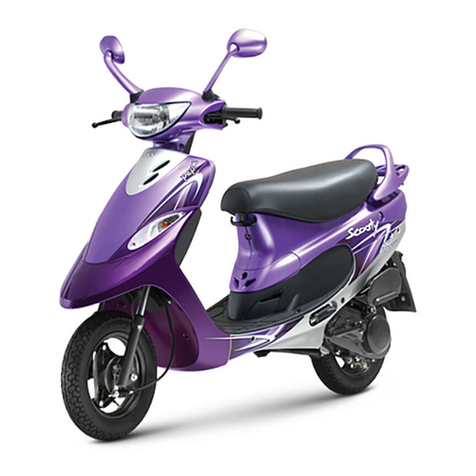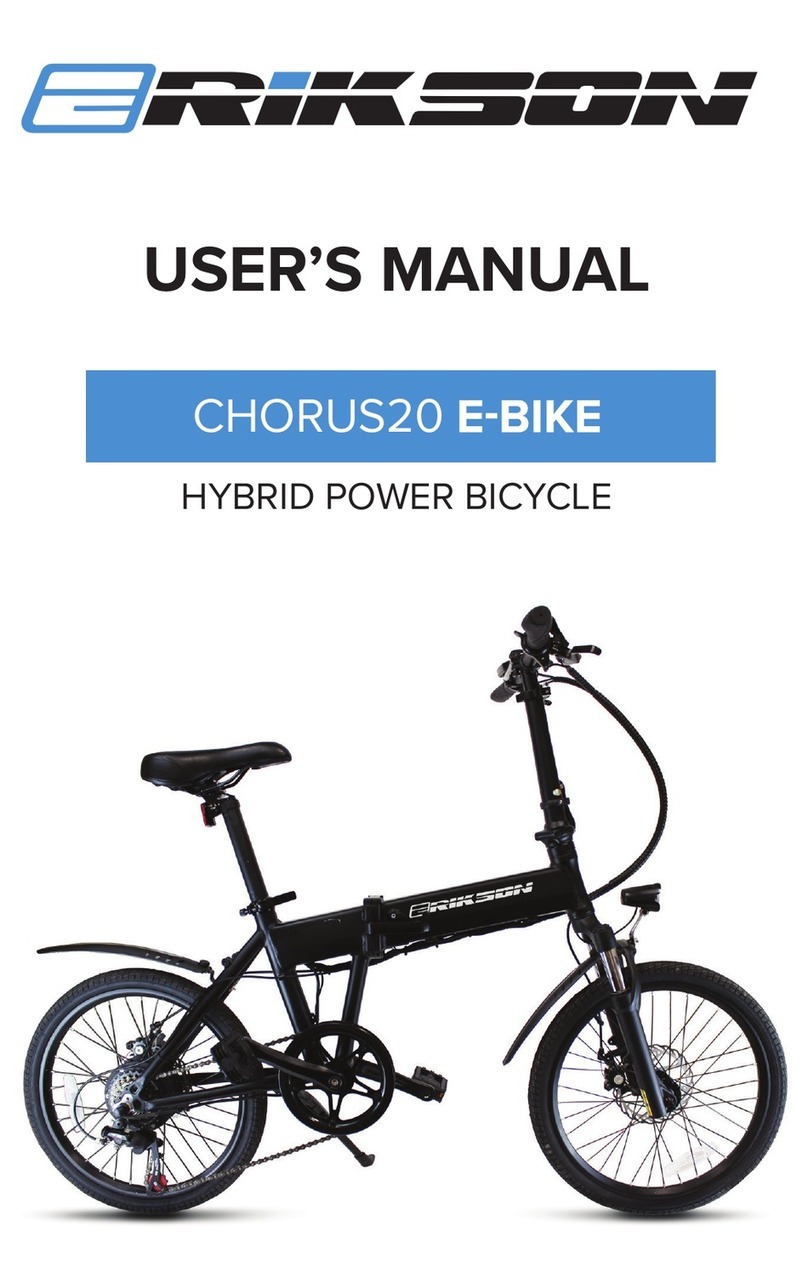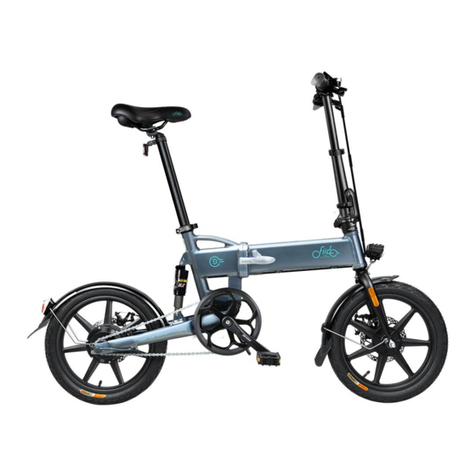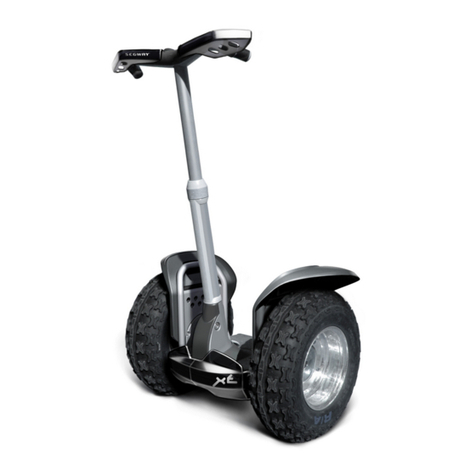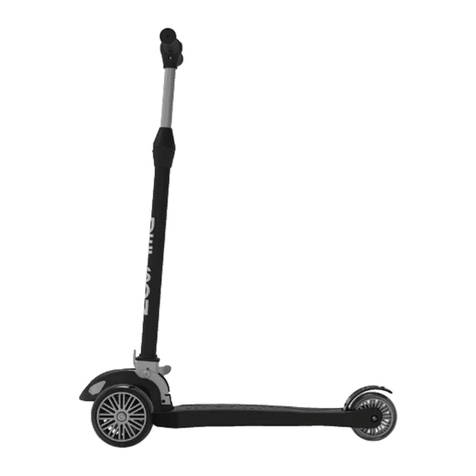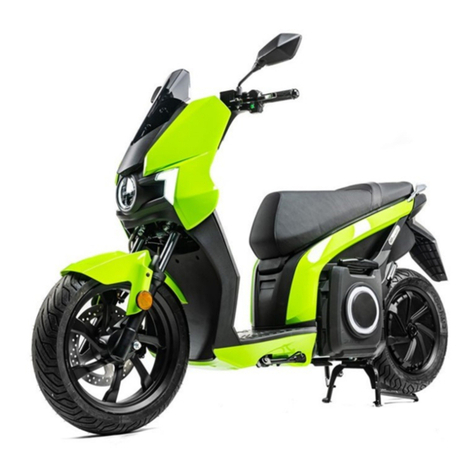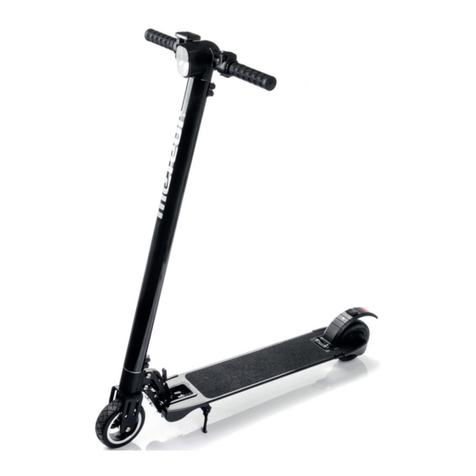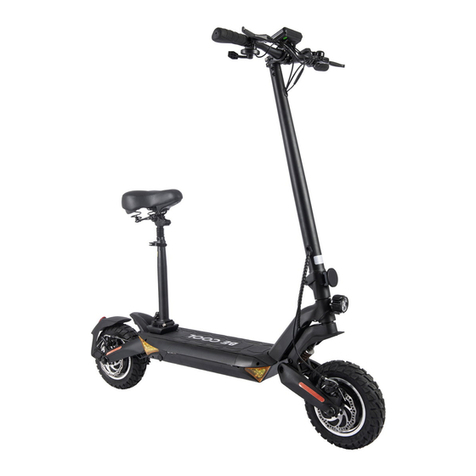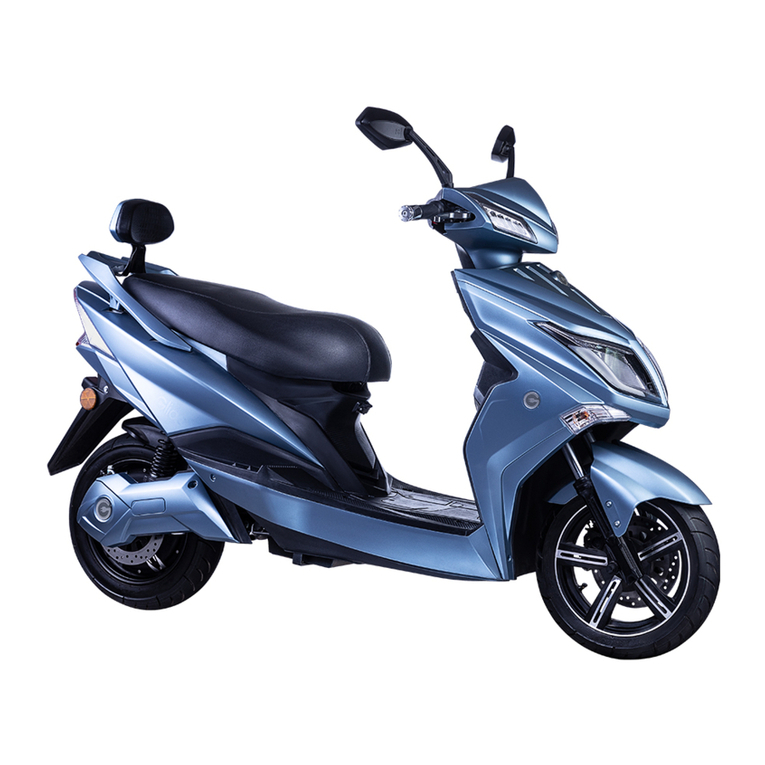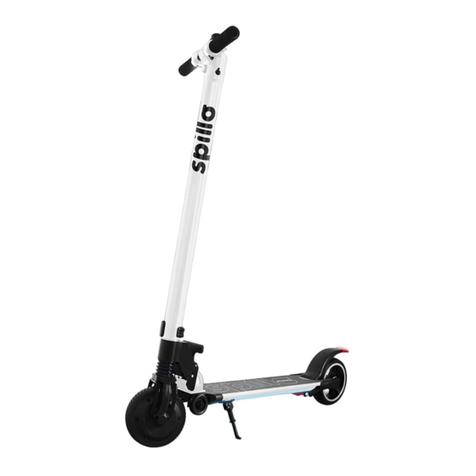Slane AJAX User manual

This user’s manual explains the operation and maintenance of your E-Bike.
Diagrams in this manual may differ from actual products; refer to your local dealer’s existing products.
Slane reserves the right to change or improve their products; further notice will not be given.
USER MANUAL
AJAX E-BIKE (Fat Tire & Regular Tire)
PLEASE READ THIS MANUAL BEFORE ASSEMBLING OR RIDING YOUR E-BIKE

TABLE OF CONTENTS
ABOUT THIS MANUAL
• Why You Should Read This Manual....................................................1
• WARNING.........................................................................................1
• Specifications.....................................................................................2
• Helmets & Reflectors.........................................................................3
OPERATING INSTRUCTIONS
• Assemble the Handlebar...................................................................4
• Install the Front Wheel……..............................................................4
• Quick Release Binder……................................................................4
• Adjusting the Steering Wheel............................................................5
• Installing the Saddle ..........................................................................5
• Pedal Installation...............................................................................5
• Adjusting the Front Brakes.................................................................6
• Adjusting the Saddle..........................................................................6
• Shifter/Derailleur/Adjusting Rear Derailleur.......................................7
• Powering ON/OFF & Entering Settings.............................................8
• Pedal Assist System (PAS)..................................................................9
• Throttle..............................................................................................9
• Unlocking & Removing Battery.........................................................10
• Battery Charging...............................................................................10
• Duration of Battery Charging...........................................................11
• Riding Safely.....................................................................................12
• Parking & Maintenance....................................................................13
• Cleaning & Inspecting your E-Bike..................................................14
• Battery Storage................................................................................15
• Power-Saving Tips ...........................................................................15
• Flat Tire/Broken Spoke.....................................................................16
• Trouble-shooting..............................................................................17
• Your E-Bike Serial Number...............................................................17
• Dealer Info & Purchase Record.........................................................18
• Warranty Policy.................................................................................18
WHY YOU SHOULD READ
THIS MANUAL
• This manual will help you get the best performance, comfort, enjoyment and safety
when riding your new E-Bike. It describes specific care and maintenance procedures
that help protect your warranty and ensure years of trouble-free use.
Pay special attention to the section on battery charging and maintenance.
• Understanding your new E-Bike’s features and operation will help you get maximum
enjoyment and safety. By reading this manual before you go on your first ride,
you’ll know how to get the most out of your new E-Bike.
• It is imperative that you take your first ride on your new E-Bike in a
controlled environment, away from cars, obstacles and other cyclists.
WARNING!
Follow these important safety measures to ensure safe riding.
• To ensure your safety, read the user manual carefully and check that all bike parts are
perfect before riding.
• Overloading is strictly prohibited. (No more than 250lbs)
• Always recharge the battery immediately after each use. Failure to do so may
damage the battery. The charger can remain plugged in for trickle-charge purposes
during long periods of storage. For storage periods over one month, the battery should
be checked and fully recharged before riding.
• There is a safety power source inside the battery box of this e-bike. Removing
the battery box will expose both jacks in the lower end ( positive pole “+” and
negative pole “- “). Please do not touch these poles with your hands at the same
time (particularly with damp hands). It is prohibited to touch any metal to either
pole (i.e., a key, etc.). Doing so will produce an unlimited short-circuit current and
will cause severe burns to the body.
• Don’t detach and disassemble spare parts or rebuild this electric bicycle.
Purchase spare parts from an authorized dealer of SLANE E-Bikes.
• If you find the cut-power function doesn’t happen when using the front or rear brake,
have it repaired immediately.
• This E-Bike can normally ride under wet conditions to a depth of water that doesn’t
surpass the electric hub center. Allowing the electric hub to be infiltrated by water will
cause damage.
• Those under the age of sixteen years of age are not permitted to ride this E-Bike.
1

2
WARNING!
CHARGE YOUR BATTERY EVERY 60 DAYS .
DO NOT MODIFY YOUR E-BIKE (YOU MAY LOSE YOUR WARRANTY).
RIDING IN RAINY OR SNOWY WEATHER IS AT YOUR OWN RISK.
DO NOT CHARGE THE E-BIKE WHEN UNATTENDED AND DISCONNECT
THE BATTERY FROM THE POWER SOURCE AFTER FULLY CHARGING.
CHARGING MUST ALWAYS TAKE PLACE IN A DRY AND CLEAN AREA.
DO NOT CHARGE THE BATTERY ON A CARPET.
TAKE EXTRA CAUTION TO THE BRAKES AND FRONT WHEEL
WHEN RIDING DOWNHILL.
• Many Provinces require specific safety devices. It is your responsibility to
familiarize yourself with the Province’s laws where you ride and comply with
all applicable laws, including adequately equipping yourself and your bike
as the law requires.
• It is strongly recommended that you wear a properly fitted bicycle safety helmet at
all times when riding your E-Bike.
The correct helmet should:
• Be Comfortable
• Be Lightweight
• Have Good Ventilation
• Fit Correctly
• Cover Your Forehead
REFLECTORS
Your E-Bike comes equipped with front/rear wheel reflectors and four pedal reflectors.
Reflectors are essential safety devices designed as an integral part of your E-Bike.
Provincial regulations require every bicycle to have front/rear wheel and pedal
reflectors. These reflectors pick up and reflect streetlights and car lights in a way
that helps you to be seen and recognized as a moving cyclist. Check reflectors
and their mounting brackets regularly to make sure they are clean, straight,
unbroken and securely mounted. Replace damaged reflectors and straighten
or tighten any that are bent or loose.
3
HELMETSSPECIFICATIONS
Net Weight (lb)
Throttle
Tire Size (in)
60 65
Yes
27.5”x 2.1
Yes
26”x 4.0
Battery Charging Time (Hr)
Pedal Assist
4-6 hr 4-6 hr
Yes Yes
Battery Capacity (Ah) 12 12
Battery Type Lithium-ion Battery Lithium-ion Battery
Suspension Front Suspension Rigid
Front & Rear Brake Disc brake Disc brake
Load Capacity (lb) 250 280
Range (km) 30-45 35-45
Speed (Km/h) 32 32
Motor Rated Voltage (V) 48 48
Motor Rated Power (W) 450 500
AJAX REGULAR TIRE AJAX FAT TIRE

4 5
WARNING!
IF THE FRONT WHEEL IS NOT FASTENED SECURELY, IT WILL CAUSE THE FRONT
WHEEL TO COME LOOSE AND CAUSE AN ACCIDENT.
ASSEMBLING THE FRONT WHEEL ADJUSTING THE STEERING WHEEL
INSTALLING THE SADDLE
• Inserted depth of vertical tube of the wheel should be no lower than minimum
depth (red safety mark). The safety mark must be below the hexagonal nut (A).
• Stand in front of the wheel, clamp the front wheel with both legs and hold the
hand-grip with both hands to adjust the angle degree between the cross tube of
hand-grip and vehicle body (B).
• Screw down the fastening screw of the wheel core. The recommended torque should
not be less than 18N.m.
• Inserted depth of saddle tube should be more than minimum depth of insert
(safety mark is for reference of minimum depth) to ensure the safety.
• Screw down clamping screw of saddle and saddle tube, recommended torque
should be not less than 18N.m. (C)
• Loosen the saddle’s clamping screw and put it into the saddle tube.
• Tighten the screw, insert the saddle tube into the vertical tube of frame;
straddle the saddle to adjust the saddle’s position, and then tighten to ensure you
can drive comfortably. (D)
INSTALL THE FRONT WHEEL
• Insert the front wheel into the fork.
• Make sure that the wheel is seated and centered
in the fork and the brake disc fits in between
the brake linings.
• Lightly apply a thin layer of grease to the axle.
• Insert the axle through the wheel making sure the
larger diameter of the spring(s) faces outward
(see diagram C).
QUICK-RELEASE BINDER
This binder is most commonly used to attach
wheels to the frame and fork or tighten a seat post
into a frame. Binders allow for a tool-free,
quicker use than nuts and bolts but require
knowledge of proper use.
• Put the lever in an opened position. (A)
• Tighten the adjustment nut (1) by small
increments until you need considerable force
to push (2) the lever to its closed position (B)
with your fingers or palm.
• Test wheel attachment by lifting the front end of
the bike and firmly hit downward on the front
wheel with your palm. There should be no play
in the connection.
ASSEMBLE HANDLEBAR
• Remove bolts and front cap of stem.
• Slide handlebar into place.
• Replace bolts, front cap of the stem
and tighten.
• Carefully position the handlebar and
stem over the bicycle.
• Ensure all cables align to each side of the
bike without being kinked, twisted or bent.
• Align the handlebar, and tighten the
headset bolt.
NOTE: THE STEM SHOULD BE IN THE PROPER
DIRECTION BEFORE ATTACHING
THE HANDLEBAR.
• Open the box from the top, take the bike, parts and accessories box out.
• Carefully remove all protective carton pieces, foam pads, tie wraps, plastic fittings,
recycle all material that can be recycled, dispose of the rest.
C.
B.
D.
A.
C.
PEDAL INSTALLATION
Pedals are a pair with “R” & “L” (Picture 1): “R” for right, “L” for left.
Tighten the pedals in the direction of the threads.
Picture 1 Right Left

76
SHIFTER/DERAILLEUR
SHIFTER
This E-bike is equipped with gears, that include:
• A rear sprocket cluster called a freewheel or cog set
• A rear derailleur
• One shifter
• One control cable
• One front sprocket
• A drive chain
There are many different types of shifter mechanisms, each preferred for specific
applications because of their ergonomic, performance and price characteristics.
A downshift is a shift to a lower or slower gear, which makes it easier to pedal.
An up-shift is a shift to a higher or faster gear, which makes it harder to pedal.
For example, you can downshift to a lower gear to make pedalling easier on a hill.
On the other hand, you may up-shift to a higher gear when you wish to go faster.
Whether up-shifting or downshifting, the derailleur system requires that the drive chain
is moving forward and is under at least some tension. A derailleur will shift only if you
are pedalling forward.
CAUTION: NEVER MOVE THE SHIFTER WHILE PEDALLING BACKWARD.
DO NOT PEDAL BACKWARDS AFTER MOVING THE SHIFTER. EITHER OF THESE
ACTIONS COULD JAM THE CHAIN AND CAUSE SEVERE
DAMAGE TO THE E-BIKE.
Shift the rear shifter to the highest number indicated,
loosen the cable from the rear derailleur cable anchor
bolt, and place the chain on the smallest sprocket.
Adjust the high limit screw so that the guide pulley
and the smallest sprocket line up vertically.
Re-tighten the cable, pull out any slack and re-tighten
the anchor bolt securely. When shifting through the
gears, make sure that each gear changes quietly and
without hesitation. It is necessary to use the barrel
adjuster to fine-tune the cable tension by turning it in
the direction you want the chain to go. For example,
turning clockwise will loosen the cable tension and
move the chain away from the wheel, while turning
counter-clockwise will tighten cable tension and
direct the chain to the wheel.
DERAILLEUR
The derailleur system includes the front and rear derailleur, the shift levers, and the
derailleur control cables, all of which must function correctly for smooth gear shifting to
occur. The front and rear derailleurs are adjusted in the factory. You will need to
inspect and adjust both before riding your E-Bike.
ADJUSTING THE REAR DERAILLEUR
ADJUSTING THE FRONT BRAKES
1. Insert an elbowed hex key into the screw port of the brake frame, turning the screw
left to loosen and right to tighten. Turn to the left gently makes the brake a little loose.
2. Hold the brake tight with your left hand so that the brake is pressed against the brake
pad (this holds the brake tight).
3. Then turn the elbowed hex key to the right of the brake until the brake is tight, then
release the brake. The brake will automatically return, the brake is in the right direction,
so that it will not wear.
To adjust the saddle (up or down) open the quick-release lever on the saddle tube.
Once you choose the correct height, close the quick-release lever. Press down on the
saddle to make sure it is locked tight into position. To check for correct saddle height,
perform the following:
• Sit on the saddle, and place one heel on a pedal.
• Rotate the crank until the pedal with your heel on it is in the down position, and the
crank arm is parallel to the seat tube. Your leg should be completely straight and just
touching the center of the pedal.
ADJUSTING THE SADDLE
Some riders prefer to have the saddle nose tilted
slightly up or down. Adjust the saddle tilt by loosen-
ing the saddle bolt, tilting the saddle to the desired
position, and re-tightening the saddle bolt. Make sure
it is tight enough so that you cannot move or jiggle
the saddle. Small changes in saddle position can have
a substantial effect on performance and comfort.
Whenever changing your saddle position, make
only one directional change at a time.

8 9
When the throttle or sensor is engaged (powering the motor), and the E-Bike is
in motion, the LED on the battery gauge (on the throttle or separate unit) indicate
instantaneous line voltage as measured at the battery terminals-not the available
energy in the available power in the battery pack.
The line voltage will wing out from a dead stop or going up a steep hill, the motor will
be under a high load and may show a reduced number of LED or show the “yellow”
or even “RED” LED.
When the throttle is disengaged (i.e. no power to the motor due to the bicycle being
stationary or coasting) LED on the throttle will indicate the battery pack’s voltage.
The voltage of the battery pack will rise when no load is on the motor. The best
indication of how much battery life is remaining is to check the throttle LED, after
reaching cruising speed, on a flat straight road. By doing this, the battery voltage
will stabilize and give a more accurate reading.
POWERING ON/OFF &
ENTERING SETTINGS
Picture 2
(ON/OFF)Press the Power button
for 3 seconds
Picture 1
I: ON O : OFF
• Press the switch on the battery case (Picture 1).
• Press the power button on the LED display to activate the battery/controller system
(Picture 2).
• Press “+“ and ” – “ to increase or decrease the speed.
• Press and hold “ +” for 2 seconds to turn on the front light, then press & hold for
another 2 seconds to turn off the front light.
• When powered on, press the power button to power off.
When powered off, the LED display monitor and the controller will no longer consume
power from the battery.
Press down on the thumb throttle slowly to avoid a sudden rush of speed forward.
The speed of the bike will increase as you press down on the thumb throttle. Release
the thumb throttle and apply the brakes to stop your bike. You will control the speed
of the bike by using both the thumb throttle and the brakes. When the brake handle is
activated it cuts power to the thumb throttle.
DO NOT USE PEDAL ASSIST AND THROTTLE AT THE SAME TIME.
PEDAL ASSIST SYSTEM (PAS)
THROTTLE
This E-Bike has an electric pedal-assisted driving system.
The pedal-assisted driving system consists of a driving unit, a battery, a controller,
and various electronic components (harness wires, sensors and switches).
It is essential to know that when the pedal assist system is on, the driving unit
provides power only while you are pedalling. The amount of power supplied by
the unit depends on your pedalling force and the assistance model/level you set with
the handlebar control unit at any time. When you stop pedalling, the pedal assist
system will disengage. In all models/levels, the pedal-assisted driving system reduces
progressively. It cuts off as the bike reaches 25KM/h (15.5MPH), or sooner if you stop
pedalling. The pedal-assisted driving system re-engages when speed drops below
25KM/H (15.5MPH) as long the pedals are turning.

1110
BATTERY CHARGING
DURATION OF BATTERY CHARGING
• When the input and output terminal are connected, the charger’s red indicator light
will light up to show that the power is connected.
• It will take 5-8 hours to charge the battery for the first time. When the charger’s
indicator light turns green, showing that the battery is fully charged, it will switch to
trickle charge mode to prevent over-charging. It takes 2-8 hours for regular charging.
• This charger has a protection device for over-charging. Long-time charging should
not be more than 24 hours because it will affect the lifetime of the battery.
Check the battery pack before using it for the first time.
• The charger doesn’t need to be grounded.
• During charging, place the charger in a safe location out of the reach of children
• The battery pack is supplied partially charged. To ensure full battery pack capacity,
completely charge the battery pack before using it for the first time.
• Retailers should charge the batteries as soon as receiving the E-Bike from the supplier.
• Even with proper care, rechargeable batteries do not last forever. Every time a battery
is discharged and subsequently recharged, its relative capacity decreases by a small
percentage. You can maximize the life of your battery by following the instructions
in this manual (see PAGE 19).
• Fully charge the battery once you receive it for the full recommended charge times.
Lithium battery recommended charging time: 6-8 hours.
• For a complete,100% charge, leave the battery on the charger for one full hour after
the charger indicator light turns green.
• Never charge batteries for longer than 24 hours.
• Li-ion batteries do not have a “memory.” Partial discharge/charge cycles will not harm
the battery’s capacity or performance.
Red Light
Indicator:
Charging
Green Light
Indicator:
Charged
• Always be sure to turn the bike power switch to “OFF” after each use. If you leave
the power switch in the “ON” position or your product has not been charged for an
extended period, the battery may reach a stage when it no longer holds a charge.
• Do not use other brands to charge this battery. Do not use this battery for a different
brand of E-Bike.
• The charger has a 110V circuit; please do not dismantle.
• When the charger is being used or stored, prevent liquid or metal from entering the
charger. The charger should be free from falling over to avoid injury.
• When using the charger, it should be left unobstructed.
• The charger is for indoor use only. When in use, keep it in a dry, well-ventilated area.
• If you detect an unusual odour or the temperature is too high during charging, stop
charging immediately and send it back to the sales department for inspection/repair.
WARNING! USE THE ATTACHED CABLES OF THE BATTERY CHARGER
FOR THE BATTERY-CHARGER ONLY!
NOTE: YOU CAN CHARGE THE BATTERY WHILE IT’S ON THE BIKE
(DURING RIDING SEASON) OR REMOVE THE BATTERY AND CHARGE
IT INDOORS (IN COLDER WEATHER/WINTER MONTHS).
Before every ride, always check the battery
capacity display on the battery case
UNLOCKING AND REMOVING THE BATTERY
• Insert key on the battery case and turn key counterclockwise to unlock the
battery pack (Picture 1).
• Carefully lift the battery out (Picture 2).
• Return the battery to the frame base, turn the key clockwise (locked position)
Picture 1 Picture 2
ALWAYS KEEP
BATTERY IN
AN UPRIGHT
POSITION
• Switch off power and remove the key.
• Remove (rotate to open) rubber stopper in the charging hole. Plug the output plug
of the charger into the socket of the battery box. Then plug the power input plug
(110-220V) into a household power socket to start the charging process.
• After charging is finished, pull out the power input plug (110-220V),
then pull out the output plug.
WARNING!
WHEN THE BATTERY IS BEING REMOVED FOR CHARGING PLEASE NOTE THAT
THE ELECTRODE “+” “-” SHOULD NEVER BE TOUCHED BY HANDS (ESPECIALLY
WET HANDS). THE ELECTRODES SHOULD NEVER TO BE TOUCHED
BY OTHER METAL OBJECTS

12
• Once you have completed the initial battery charge, you are ready to ride.
• It is your responsibility to know and abide by all local laws that govern and
restrict electric bicycle use.
• Before riding, familiarize yourself with all the different parts of the e-bike and always
make sure that all the electrical components are in working order.
• Ensure all the bicycle parts are in good condition, i.e. battery power level,
tire pressure and brakes.
Hold onto the handlebars with both hands. Assume a well-balanced position on the
E-Bike and push off with your foot. Your left hand will control the throttle. Press down
on the thumb throttle slowly to avoid a sudden rush of speed forward. The speed of the
E-Bike will increase as you press down on the throttle. Release the throttle and apply the
brakes to stop your E-Bike. You will control the speed of the E-Bike by using both the
throttle and the brakes. Squeezing the brake handles cuts power to the throttle.
RIDING ON THE ROAD
• Obey the same road laws as all other road vehicles, including yielding to pedestrians
and stopping at red lights and stop signs.
• Ride predictably and in a straight line. Never ride against traffic.
• Use correct hand signals to indicate turning or stopping.
• Ride defensively. To other road users, you may be hard to see.
• Concentrate on the path ahead. Avoid potholes, gravel, wet road markings, oil, curbs,
speed bumps, drain grates and other obstacles.
• Expect the unexpected such as opening car doors or cars backing out of concealed
driveways.
• Be very careful at intersections and when preparing to pass other vehicles.
• Familiarize yourself with all the bike’s features: practice braking and the use of horns.
• Don’t carry packages or passengers that will interfere with your visibility or control
of the bike. Don’t use items that may restrict your hearing.
• Maintain a comfortable stopping distance from all other riders, vehicles and objects.
Safe braking distance is subject to weather conditions.
RIDING IN WET CONDITIONS
• Brake earlier; it will take a longer distance to stop.
• Decrease your riding speed, avoid sudden braking, and take corners
with additional caution.
• Be more visible on the road by wearing reflective clothing and using safety lights.
• The local standard weight is 90kg (including the rider weight); do not overload.
• Potholes and slippery surfaces such as line markings, train tracks and wood become
more hazardous when wet.
NIGHT RIDING
• Ensure that the front lights (if equipped) are on.
• Wear reflective and light coloured clothing.
• Ride at night only if necessary. Slow down and use familiar roads with street lighting.
RIDING SAFELY
13
MAINTENANCE
Technological advances have made the E-Bike and the components more complex
than ever before. The pace of innovation is increasing. This ongoing evolution makes it
impossible for this manual to provide all the information required to properly repair and
maintain your E-Bike. To help minimize the chances of an accident and possible injury,
you must have any repair or maintenance performed by your dealer, not explicitly
described in this manual.
Your maintenance requirements are determined by everything from your riding style
to geographic location. Consult your dealer for help in determining your maintenance
requirements. How much of your E-Bike service and maintenance you can do yourself
depends upon your level of skill, experience, and special tool availability.
WARNING
MANY E-BIKE SERVICE AND REPAIR TASKS REQUIRE KNOWLEDGE AND TOOLS.
DO NOT BEGIN ANY ADJUSTMENTS OR SERVICE ON YOUR E-BIKE IF YOU HAVE
THE SLIGHTEST DOUBT ABOUT YOUR ABILITY TO COMPLETE THEM CORRECTLY.
IMPROPER ADJUSTMENT OR SERVICE MAY DAMAGE THE E-BIKE
OR CAUSE AN ACCIDENT RESULTING IN SEVERE INJURY OR DEATH.
INSPECTION, SERVICE & MAINTENANCE
For your safety and enjoyment and to ensure a longer life for your E-Bike, inspect
and maintain your E-Bike regularly. You must check specific systems and components
before every ride. To ensure your safety, the proper condition and function of these
systems are critical. You can perform some service and maintenance and require no
special tools or knowledge beyond what is written in this manual. All other service
maintenance and repair should be performed in a properly equipped facility by a
qualified E-Bike mechanic using the correct tools and procedures specified by
the manufacturer.
Your E-Bike will last longer and work better if you break it in before riding it hard.
Control cables and wheel spokes may stretch or sear when a new E-Bike is first used
and may require readjustment by your dealer. Your mechanical safety check will help
you identify some things that need readjustment. Even if everything seems fine, it is
best to take your E-Bike back to the dealer for a checkup. Dealers typically suggest you
bring the E-Bike in 30 days after purchase for a checkup. Another way to judge when it’s
time for the first checkup is to service the E-Bike after 10 to 15 hours of use. If you think
something is wrong with the E-Bike, take it to your dealer before riding it again.
PARKING
• Shut off the power switch after you get off to prevent an unintentional abrupt start-up
of the bicycle
• Do not start-up E-Bike frequently while resting to ensure the battery, motor, and
electric switch’s service life.
• Shut off the power after parking and remove the key.
• When the E-Bike power is on, and a person does not sit on the saddle: do not turn the
throttle; otherwise, it will cause the E-Bike to rush forward.

CLEANING YOUR E-BIKE
To avoid damage or accidents caused by wet inner electrical parts, do not wash your E-bike with
a high-pressure washer. Clean off dirt on any painted metal or plastic parts with a damp cloth
using a mild cleaning product. Dry off immediately. Use lubrication oil to maintain any metal
parts of the bike. Never apply oil to the front or back brake rubber, hand brake levers, rim,
tires, battery or controller.
BEFORE EVERY RIDE
• Perform a mechanical safety check to make sure all components are in good
working order.
AFTER EVERY LONG OR HARD RIDE, IF THE
E-BIKE IS EXPOSED TO WATER OR GRIT OR
AT LEAST EVERY 100 MILES
• Clean the E-Bike.
• Lightly oil the chain, freewheel cogs and rear derailleur pulley bushings. Wipe off
excess oil. Lubrication is a function of climate. Talk to your dealer about the
best lubricants and the recommended lubrication frequency for your area.
AFTER EVERY LONG OR HARD RIDE
OR EVERY 10 TO 20 HRS OF RIDING
• Squeeze the front brake and rock the E-Bike forward and back. Does everything feel
solid? If you feel a clunk with each forward or backward movement of the E-Bike, you
probably have a loose headset. Take your E-bike to your Dealer for inspection.
• Lift the front wheel off the ground and swing it from the side. Does it feel smooth? If
you feel any binding or roughness in the steering, you may have a tight headset.
Take your E-bike to your Dealer for inspection.
• Make sure all bolts, nuts and mounting hardware are tight.
WARNING
LIKE ANY MECHANICAL DEVICE, AN E-BIKE AND ITS COMPONENTS ARE
SUBJECT TO WEAR AND STRESS. DIFFERENT MATERIALS AND MECHANISMS
WEAR AT DIFFERENT RATES AND HAVE DIFFERENT LIFE CYCLES. ONCE A PART
IS NO LONGER WORKING OR DAMAGED, IT CAN SUDDENLY AND
CATASTROPHICALLY FAIL, CAUSING SEVERE INJURY OR DEATH TO THE RIDER.
SCRATCHES, CRACKS, FRAYING AND DISCOLORATION ARE SIGNS OF
STRESS-CAUSED WEAR AND INDICATE THAT A PART REQUIRES REPLACING.
BATTERY STORAGE
STORING YOUR BATTERY FOR AN EXTENDED PERIOD
• Charge your battery every 60 days to avoid capacity loss. Batteries will slowly
self-discharge when left unused for an extended period. Your battery lifespan and
capacity will be permanently reduced if you allow the battery cells to reach a critically
low voltage.
• Always disconnect your charger from the wall outlet and battery before storing
the battery.
• Avoid storing your batteries in extreme hot or cold temperatures.
Do not store outdoors.
• Batteries should be kept in a cool, dry place. Do not allow batteries to accumulate
condensation; this could cause shorting or corrosion.
• The recommended storage temperature for Li-ion batteries is between 32-77ºF
(0-25ºC).
• Avoid exposing the battery to extreme heat (104ºF or higher) for long periods.
Q: Is it normal that the batteries get warm when recharging?
A: Yes, the batteries will become warm to the touch during the recharging process due
to increased internal resistance and less energy conversion efficiency from electric
energy to chemical energy.
Q: How long will my batteries last before needing replacement?
A: Average battery life depends on use and conditions. Even with proper care,
rechargeable batteries do not last forever. Conservatively, an SLA battery will come to
the end of its useful after~350full discharge charge cycles. In contrast, LI-ION batteries
will last more than 800cycles. A partial charge/discharge counts fractionally against those
numbers; running the battery down halfway then recharging it completely uses up one
half of a charge cycle. “End of useful life” refers to the point at which a battery can no
longer supply 60% of its original rated capacity in ampere-hours. After this point, the
aging process will accelerate; the battery needs replacing.
POWER-SAVING TIPS
• The life of the battery depends on using it correctly.
• Use Pedal-Assist when riding uphill.
• Charge your battery promptly and at regular intervals if you don’t ride
your E-bike for long periods.
• Press down on the throttle slowly; do not press it too quickly when you speed up.
• In general, riding at a consistent speed of 15-18km/h will save the most power.
• Avoid excessive braking when you ride your E-bike.
14 15

FLAT TIRE
If you get a flat tire, remove the wheel and depress the tire valve to let all the air out of the tube.
Remove one bead of the tire from the rim by grasping the tire at a point opposite the valve stem
with both hands lifting and peeling one side of the tire off the rim. If the bead is too tight to unseat
it with your hands, use tire levers to lift the bead carefully over the tire rim. Push the valve stem
through the wheel rim. Remove the inner tube. Carefully check the outside and inside of the tire
for the puncture cause and remove it. If the tire has a cut, line the inside of the tire in the area of the
cut with tape, a spare patch, a piece of an inner tube, or a dollar bill-whatever will keep the cut from
pinching the inner tube. Patch the tube (follow the instructions in your patch kit) or use a new tube.
Reinstall the tire and tube. Slip one tire bead over the rim. Insert the tube valve through its hole
in the rim, feed the tube carefully into the tire’s cavity. Inflate the tube just enough to give it some
shape. Start at the valve stem, use your thumbs to seat the tire bead inside the rim, and work your
way around both sides of the wheel until the entire bead is seated in the rim. Be careful not to pinch
the tube between the tire bead and the wheel rim. If you have trouble getting the last few inched
of bead over the edge of the rim with thumb pressure, use a tire lever and be careful not
to pinch the tube.
CAUTION
Using any tool other tool than a tire lever will likely puncture the tube. Check to make sure the tire is
evenly seated around both sides of the rim and that the tube is inside the tire beads. Push the valve
stem into the tire to ensure that its base is seated within the tire’s beads. Inflate the tube slowly to
the recommended pressure, all the while checking to make sure that the tire beads stay seated in
the rim. Replace the valve cap, and install the wheel onto the E-Bike.
WARNING:
RIDING YOUR E-BIKE WITH A FLAT OR UNDER INFLATED TIRE CAN DAMAGE
THE TIRE, TUBE, AND E-BIKE AND CAUSE YOU TO LOSE CONTROL AND FALL.
BROKEN SPOKE
A wheel with a loose or broken spoke is much weaker than a fully tensioned wheel. If you break a
spoke while riding, you will have to ride much more slowly and carefully because the weakened
wheel could break additional spokes and become useless.
WARNING:
A BROKEN SPOKE SERIOUSLY WEAKENS THE WHEEL AND MAY CAUSE IT TO
WOBBLE, STRIKING THE BRAKES OR THE FRAME. RIDING WITH A BROKEN
SPOKE CAN CAUSE YOU TO LOSE CONTROL AND FALL.
Twist the broken spoke around the spoke nest; it will keep it from flopping around and getting
caught between the wheel and the frame. Spin the wheel to see if the rim clears the brake pads.
If the wheel does not turn, try turning the brake cable adjusting barrel(s) clockwise to slacken the
cable and open up the brakes. If the wheel still won’t turn, open the brake’s quick release and
secure any loose as best you can. Walk the E-Bike, or if you must, ride it with extreme caution
because you now have only one working brake.
TROUBLE-SHOOTING
Malfunction Analysis of Malfunction Solution
E-Bike won’t start
Fails to adjust the
speed or max speed is
relatively slow
Motor doesn’t work
after switching on
Not getting enough
mileage after a charge
Charger doesn’t
charge
1. Low voltage of battery
2. Bad connection between battery
case and socket
3. Power lock switch is not in
the correct position
1. Low voltage of battery
2. The throttle is loose
3. The throttle or speed sensor
is damaged
1. Wire connection is loose
2. Connectors of motor wire
connection are loose or damaged
1. The tire’s air pressure is low
2. Not enough charging or charger fault
3. Too much up slope, heavy dead
wind, braking too much,
carrying big load
4. Battery has been discharged
completely for long period of time,
not charged in time, the battery is
aging or damaged
5. Charging during low temperature/
freezing can affect the mileage
1. Socket of charger falls off or is loose
between plug and socket
2. Burnt fuse in battery case
3. Wire connection of battery falls off
1. Charge the battery
2. Clean any dirt off the
connection points (*)
3. Turn to correct position
1. Charge the battery
2. Tighten the throttle
3. Take in to qualified technician (*)
1. Re-connect
2. Take in to qualified technician (*)
1. Inflate tire
2. Fully charge or change the charger
3. Use pedal-assist more often
4. Change the battery
5. Charge the battery indoors
1. Tighten socket and connector
2. Change the fuse
3. Solder the connection wire(*)
*Consult your dealer as needed and always use approved replacement parts,
especially the safety-critical components.
SERIAL NUMBER
Your E-Bike’s Serial Number can be found on the
front stem tube. Please take note of this number
and record it on page 20 of this manual.
16 17

DEALER INFO AND
PURCHASE RECORD
WARRANTY POLICY*
Your name:
Address:
Date purchased:
Place of purchase:
Model & brand information:
Wheel size:
Color:
Serial number:
Handlebar, Frame, Front
Fork, Steering Column,
Rear Flat Fork
1 Year
Lithium-Ion Battery 1 Year
Charger 1 Year
Controller 1 Year
Motor 1 Year
NO. WARRANTY
Broken
Not Working
Functional Failure
Functional Failure
Not Working
DESCRIPTION OF PROBLEM
*Note: The warranty starts on the purchase date of the E-bike.
The warranty covers quality problems and or functional failures.
The warranty does NOT cover tires, tubes, chains or spokes.
The warranty does NOT cover misuse or accidents caused by the rider.
THANK YOU FOR CHOOSING
HAVE FUN AND RIDE SAFE!
Fill in immediately and retain as a record of your purchase.
Retain your sales receipt for any possible warranty claims*
18 19
Table of contents
Other Slane Scooter manuals
